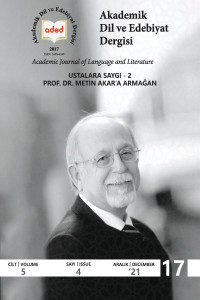An Overview of Existentialism and Its Reflections in Turkish Literature and Intellectual Life with Its Outlines
Abstract
Existentialism is a concept named by the Danish theologian and philosopher Søren Kierkegaard, and over time, its meaning has expanded, especially in the branches of literature and art, and has been reproduced and transformed into a transcendent form. According to Kierkegaard, Existentialism is the rejection of all purely abstract thought, of a purely logical or scientific philosophy; In short, it is the rejection of the absoluteness of reason. Existentialism first emerges as a defiant voice against the absurdity of Pure Thought, reminding the individual of how one can approach the problems and possibilities of his own conditioned thought from the fallacies of Pure Thought and strive to return to the self he knows. The basis of existentialism is the individual's showing his "will to exist", which will make him meaningful. Existentialism always advocates the freedom of the individual, artistically and politically. Existentialists envision the individual as creative, libertarian, suffering (painful), thinking. Among all these features, we come across a bohemian (rint) type, which is perhaps depicted with the influence of the spirit of the time (zeitgeist). They argue that human beings born as biological beings should be existential individuals by accepting responsibility for their actions. The existential individual, which Sartre calls the "free organic individual", is in constant conflict with modern society and his inner world. The existential individual's search for questioning and making sense of himself and his environment is continuous. In this context, the existential individual claims to be "authentic". As a result, while the supreme value of existential thought is often regarded as freedom, its essential virtue is originality. This study tries to outline the framework of Existentialism around these concepts and to examine how this philosophical orientation transforms into a transcendent state and affects other disciplines.
References
- Camus, A. (2010). Sisifos Söyleni. Can Yayınları.
- Çetişli, İ. (2001). Batı Edebiyatında Edebî Akımlar. Akçağ Yayınları.
- Edgar, A. & Sedwick, P. (2002). Cultural Theory-The Key Thinkers. Routkedge Press.
- Flynn, T. (2006). Existentialism-Very Short Indroduction. Oxford University Press.
- Foley, J. (2014). Albert Camus, From the Absurd to Revolt. Routledge.
- Hançerlioğlu, O. (1976). Felsefe Ansiklopedisi, 7 C. Remzi Kitabevi.
- Kısakürek, N. F. (2010). Çile, Büyük Doğu Yayınları.
- Kurt, M. (2009). Varoluşçuluğun Türk Edebiyatına Girişi ve Etkileri. Gazi Türkiyat, Bahar(4).
- Quinn, E. (2006). A Dictionary and Thematic Terms. Facts On File Publishing.
- Sartre, J.-P. (1985). Varoluşçuluk(Existentialisme). Say Yayınları .
- Sartre, J.-P. (2010). Varlık ve Hiçlik/Fenomenolojik Ontoloji Denemesi, İthaki Yayınları.
- Topçu, N. (2017). Varoluş Felsefesi-Hareket Felsefesi. Dergâh Yayınları.
- Ülken, H. Z. (1968). Varlık ve Oluş, Ankara Üniversitesi Basımevi.
- Yahya Kemal, Kendi Gök Kubbemiz(1974). Yahya Kemal Enstitüsü Yayınları.
Abstract
Varoluşçuluk Danimarkalı ilahiyatçı ve filozof Søren Kierkegaard tarafından adlandırılmış bir kavram olup zamanla edebiyat ve sanat dalları başta olmak üzere anlamı kapsamı genişleyerek yeniden üretime tabi tutularak aşkın bir şekle bürünmüştür. Kierkegaard ‘a göre Varoluşçuluk tüm salt soyut düşüncenin, salt mantıksal veya bilimsel bir felsefenin reddidir; kısacası, aklın mutlaklığının reddidir. Varoluşçuluk, önce Saf Düşünce’nin saçmalığına karşı aykırı bir ses olarak ortaya çıkar, Saf Düşünce'nin safsatalarından, problemlere ve kendi koşullu düşüncesinin olanaklarına, nasıl yaklaşılabileceğini ve bildiği özüne dönme gayretinde olan bireyi hatırlatır. Varoluşçuluğun temelinde bireyin kendisini anlamlı kılacak olan “varolma iradesi” ni göstermesi yatmaktadır. Varoluşçuluk sanatsal ve politik anlamda daima bireyin özgürlüğünü savunur. Varoluşçular bireyi yaratıcı, özgürlükçü, acı çeken(sancılı), düşünen olarak tasavvur eder. Tüm bu özellikler içerisinde belki zamanın ruhu(zeitgeist)’nun da etkisiyle resmedilen bir bohem(kalender meşrepli/rint) tipi karşımıza çıkar. Biyolojik varlıklar olarak doğan insanın, eylemleriyle sorumluluk kabul ederek varoluşsal bireyler olması gerektiğini savunurlar. Sartre'ın “özgür organik birey” olarak adlandırdığı varoluşsal birey modern toplumla ve kendi içsel dünyasıyla sürekli çatışma hâlindedir. Varoluşsal bireyin kendisini ve çevresini sorgulama ve anlamlandırma arayışı süreklilik arz eder. Bu bağlamda varoluşsal birey “özgün(otantik)” olma iddiasındadır. Sonuç olarak varoluşçu düşüncenin en yüce değeri genellikle özgürlük olarak kabul edilirken, temel erdemi özgünlüktür. Bu çalışma işte bu kavramlar çevresinde ana hatlarıyla Varoluşçuluk’un çevçevesini çizmeyi, bu felsefi yönelimin nasıl aşkın bir hâle dönüşerek diğer disiplinleri de etkilediğini irdelemeye çalışmaktadır.
References
- Camus, A. (2010). Sisifos Söyleni. Can Yayınları.
- Çetişli, İ. (2001). Batı Edebiyatında Edebî Akımlar. Akçağ Yayınları.
- Edgar, A. & Sedwick, P. (2002). Cultural Theory-The Key Thinkers. Routkedge Press.
- Flynn, T. (2006). Existentialism-Very Short Indroduction. Oxford University Press.
- Foley, J. (2014). Albert Camus, From the Absurd to Revolt. Routledge.
- Hançerlioğlu, O. (1976). Felsefe Ansiklopedisi, 7 C. Remzi Kitabevi.
- Kısakürek, N. F. (2010). Çile, Büyük Doğu Yayınları.
- Kurt, M. (2009). Varoluşçuluğun Türk Edebiyatına Girişi ve Etkileri. Gazi Türkiyat, Bahar(4).
- Quinn, E. (2006). A Dictionary and Thematic Terms. Facts On File Publishing.
- Sartre, J.-P. (1985). Varoluşçuluk(Existentialisme). Say Yayınları .
- Sartre, J.-P. (2010). Varlık ve Hiçlik/Fenomenolojik Ontoloji Denemesi, İthaki Yayınları.
- Topçu, N. (2017). Varoluş Felsefesi-Hareket Felsefesi. Dergâh Yayınları.
- Ülken, H. Z. (1968). Varlık ve Oluş, Ankara Üniversitesi Basımevi.
- Yahya Kemal, Kendi Gök Kubbemiz(1974). Yahya Kemal Enstitüsü Yayınları.
Details
| Primary Language | Turkish |
|---|---|
| Subjects | Literary Studies |
| Journal Section | Articles |
| Authors | |
| Publication Date | December 30, 2021 |
| Submission Date | October 8, 2021 |
| Acceptance Date | December 3, 2021 |
| Published in Issue | Year 2021 Volume: 5 Issue: 4 |

